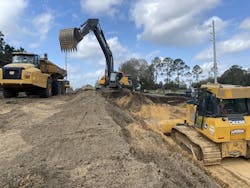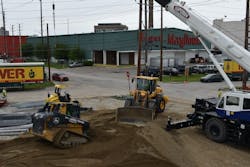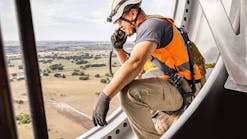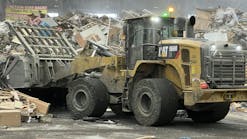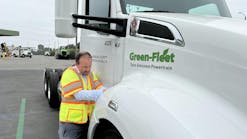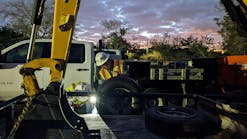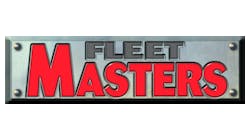Small-fleet Fleet Masters Award winner Superior Construction is in the midst of one of its largest projects to date, the $300-million “North Split” project at the junction of Interstates 65 and 70 in downtown Indianapolis that involves replacing 52 bridges, changing lane configurations to ease bottlenecks, ramp work, and concrete paving.
It’s a massive two-year undertaking that may not have been possible without fundamental changes to the company’s equipment department under the leadership of Ernest Stephens, CEM, corporate equipment manager, and Brian Connolly, CEM, regional equipment manager. Both men joined Superior from large construction companies six and five years ago, respectively.
Not only did Stephens and Connolly change the way Superior’s fleet is procured, managed, and maintained, but they also transformed the relationships the company has with its dealers and vendors. Those relationships are making a difference on a number of levels.
Superior Construction, Portage, Indiana, is the small-fleet winner of the 2021 Fleet Masters Award. Large-fleet winner Barriere Construction is profiled here. The awards are presented by Construction Equipment and the Association of Equipment Management Professionals (AEMP) and are judged on categories such as finance, information management, policies, and controls.
One of the first changes involved the use of alternative procurement methods such as leasing to help keep the balance sheet strong for requirements on larger projects.
“When you’re successful bidders on large projects, you then have to supply the people and equipment for those jobs,” Stephens says. “As the company continued to grow, the increased capex that we were spending—up to 25 percent annually on pickup trucks alone—could not be sustained.
Why lease equipment?
“We quickly realized something needed to change, so we began to investigate alternative procurement methods to help acquire our massively growing fleet,” Stephens says. “Our first leases were on pickup trucks. The process seemed to be working well so we started on a few excavators and dozers. Over the last couple years, and after several tweaks to our methods, we now lease the majority of our commodity equipment—wheel loaders, excavators, and dozers—and vehicles.
“With the leases, we are still able to have very competitive pricing for our projects and keep cash in hand for the company,” Stephens says. “The costs are spread out monthly on the leases as opposed to large one-time hits to our capex. There are new Financial Accounting Standards Board standards that apply on the back-end, but the cash is still in the company.
“With the help of alternative procurement methods, we now have a strategic mix of owned, leased, RPOs, and straight rental in our fleet,” Stephens explains. “One of the biggest benefits is that we rarely have equipment sitting without a home. We can always swap out a rental if an owned/leased unit comes available from a different project.”
On the management and maintenance side, Superior has been able to maximize its telematics use, successfully placing 90 percent of its mixed (brand) fleet into one portal. It’s been a key development for the North Split project.
“We found a good vendor [ES Track] to pull in all of the existing OEM feeds that we had,” Connolly says. “We started with 25 of their devices for our older equipment and then we started pulling in one manufacturer at a time.
“Pulling in just one OEM at a time was the key for us,” Connolly says. “They all took different steps both internally and externally to get the information into the open portal and feeding into our systems. It’s not as easy as some might think. We pretty much play the mediator, between all the OEMs and our systems. When, not if, the link breaks and we get an error message, we have to see what OEM made an update or if our internal IT department made changes.”
Connolly describes the process as painstaking but ultimately worth it. “Now we’re up over 500 assets in that one portal on ES Track,” he says.
“When our mechanic arrives on a job site, he can look up his work order on his iPad and see exactly where the equipment is located within the maintenance software,” Connolly says. “That’s also feeding our information for planning preventive maintenance and scheduling downtime.”
Never in the history of the company has it been more critical. “On a project like this [North Split], we’ve got to plan our maintenance a week or two out,” Connolly says.
Along with scheduling crane maintenance and movements, lane closures and large operations such as pile driving also have to be considered.
“That’s what we’re forecasting now with the local equipment dealers—inventory needs,” Stephens says. “We’ve already transacted 15 commodity equipment needs and four cranes that we know are going to be here for project duration. Next is determining what we’re going to need for the peak work. In two to three months, we’re going to need several more excavators and dozers. With ongoing equipment shortages, it’s crucial for us to communicate those needs and work things out now with the dealers.”
Stephens and Connolly have spent considerable time honing relationships with dealers, OEMs, and vendors.
How to build dealer relationships
“We’re really being very open in communicating with all the dealers here in town,” Stephens says. “The days of calling Friday to get something on Monday are really over. Brian and I take part in a daily scheduling meeting with the project operations team just to listen in and hear what’s going on.
“We try to get insight from their planning,” Stephens says. “Every day it seems like we pick something out of those meetings that most equipment managers wouldn’t hear about until it’s too late. It’s kind of cool to be part of the team like that.”
Vendor partnerships with Superior are valuable for more than just sales, leases, or rentals.
“On this project, we have utilized our vendors not just for equipment needs, but also for operator training and for their equipment application knowledge,” Stephens says.
“This has been especially important on pile-driving applications for this project,” Stephens says. “We’ve met with multiple industry dealer reps just to get their thoughts and ideas. The last thing we talk about is rental rates. Utilizing their skills and industry knowledge will help us get the job done right the first time.”
Stephens advises putting the AEMP equipment triangle (end user, OEM, dealer/supplier) to the test.
“Allow your dealers and your OEMs to play a key role in your decision-making,” Stephens says. “Bring them to the table. It’s not just them trying to sell you something. It’s bringing them to your house and saying, ‘This is our next project. What do you guys think? What will it take to build? How many of these do we need? Are they readily available? What’s the capacity, what are the fuel burns? Okay—now—what’s my pricing?’”
Stephens says working with vendors on the whole project, up front, is going to make it more likely the company will be able to work with them long-term.
“The OEMs and dealers will grow with you the more you let them,” he says. “I feel like they work for us now on the same team.”
